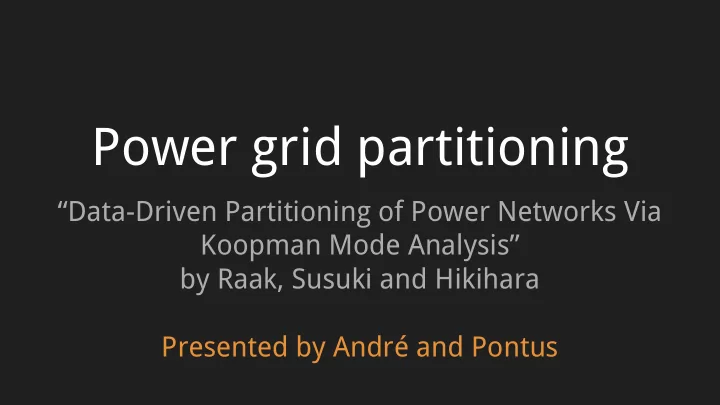

Power grid partitioning “Data-Driven Partitioning of Power Networks Via Koopman Mode Analysis” by Raak, Susuki and Hikihara Presented by André and Pontus
http://energy.gov/sites/prod/files/oeprod/DocumentsandMedia/BlackoutFinal-Web.pdf 2
http://ieeexplore.ieee.org/xpls/abs_all.jsp?arnumber=1717588 3
Agenda Controlled islanding Why? How? Previous methods Modelling Partitioning Proposed method Koopman modes Math! Results & Conclusions 4
Controlled islanding - why? Stop faults from cascading! Power outage in 2003 due to one tree (and contributing factors)! Disturbances cause the grid to oscillate 5
Controlled islanding - how? Separate the grid into smaller grids Isolate faults Quicker recovery Maintain power balance! Generation ≈ Load Create islands with balanced load and high stability Solving this is the main problem! 6
Controlled islanding - how? Many previous methods: Model the grid’s dynamic properties down to individual components Group power buses by some (dynamic) property Create islands from suitable grouping 7
Previous methods http://ieeexplore.ieee.org/document/1717588/ 8
Previous methods 9
Previous methods 10 http://icseg.iti.illinois.edu/ieee-118-bus-system/
Previous methods Based on linear models Requires (hundreds or thousands of) accurate parameters for all parts of the grid Generators Transformers Power lines Loads … Often calculated offline, as steady-state systems 11
Is there a better method? Real disturbances are dynamic - far from steady-state! However, slow coherency successful on simulations of the blackout in 2003! Slow coherency groups buses by their calculated low-frequency modes 12
New method wishlist Data-driven - no grid parameters! Make decisions based on the real dynamics of the system Not confined to linearized models 13
Koopman operator “Hamiltonian systems and transformation in Hilbert space” Bernard Koopman, 1931 Linear operator that captures nonlinear phenomena Used in many dynamic systems, such as fluid dynamics By sampling phase angles we can find the dynamic modes! Find buses that oscillate in harmony 14
Math! States � ∈ � represent the phase angles of all the buses System evolves over time as phase angles oscillate (naturally, or due to disturbances) We want to know the dynamics of the oscillations! 15
Math! Function that generates the next state from the current state Observable, i.e. measurement 16 All following slides: http://ieeexplore.ieee.org/document/7243366/
Math! Koopman operator! Eigenfunction 17
Math! We are interested in the dynamic properties of the system Koopman operator is linear For our case: i:th Koopman eigenvalue i:th Koopman mode i:th eigenfunction 18
Now it gets a little complicated... 19
Complications Calculating eigenvalues and modes from measurements is “challenging” Approximate with an Arnoldi-type algorithm to get: 20
Finding partitions We want to group the buses in the grid by the “largest” dynamic properties Sort the calculated modes and eigenvalues by growth rate | λ i | and norm || � i || 21
Finding partitions We want to group the buses in the grid by the “largest” dynamic properties Sort the calculated modes and eigenvalues by growth rate | λ i | and norm || � i || Calculate how tightly buses conform to each dominant mode Discard modes that do not have a tight grouping Partition (using k-means) according to phase angle 22
Tightness of grouping (approx.) 23
24
Result Large correlation with other methods The method captures essential dynamic properties, without modelling! Finds all partitionings that slow coherency and graph bisectioning find Not yet a deployable method Sensitive to noise (use filtering!) Phasor Measuring Units are not installed at all buses Effect of unsynchronized measurements is unknown 25
Conclusions Cascading failures can be a problem in sensitive grids (ran at their limit) Previous methods required detailed models New method uses measurements to find dynamics of system Captures essential properties of previous methods, without modelling Still a research topic! 26
Read more! Yang, B., Vittal, V., & Heydt, G. T. (2006). Slow-Coherency-Based Controlled Islanding - A Demonstration of the Approach on the August 14, 2003 Blackout Scenario. IEEE Transactions on Power Systems , 21(4), 1840-1847. Susuki, Y., Mezic, I., Raak, F., & Hikihara, T. (2016). Applied Koopman operator theory for power systems technology. Nonlinear Theory and Its Applications , IEICE, 7(4), 430-459. (Reading list) 27
Recommend
More recommend